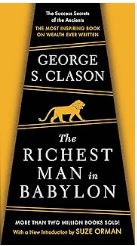 Click on the book to buy on Amazon
Click on the book to buy on Amazon
"The Richest Man in Babylon" by George S. Clason is a
timeless classic that offers practical financial wisdom through a
collection of parables set in ancient Babylon. These stories convey
essential principles of wealth accumulation and personal finance
that remain relevant today. Here's a detailed summary of the key
concepts and chapters:
Introduction: The Wealth of Babylon
Clason introduces the book's central theme: the timeless
principles of wealth-building and financial success as practiced by
the inhabitants of ancient Babylon. He explains that the wisdom
contained in the book is as relevant today as it was thousands of
years ago.
Part 1: The Man Who Desired Gold
Chapter 1: The Man Who Desired Gold
The story follows Arkad, the richest man in Babylon, as he shares
his secrets of wealth accumulation with a group of eager listeners.
Arkad emphasizes the importance of saving, investing, and living
below one's means to achieve financial success.
Chapter 2: The Richest Man in Babylon
Arkad recounts his humble beginnings as a poor scribe in Babylon
and reveals how he transformed his financial fortunes through
disciplined saving and prudent investing. He shares the "Seven Cures
for a Lean Purse," which include paying oneself first, controlling
expenses, and investing wisely.
Chapter 3: Seven Cures for a Lean Purse
Arkad explains each of the seven cures in detail, offering
practical advice and timeless wisdom for achieving financial
prosperity. These cures include setting aside a portion of one's
income for savings, avoiding debt, and seeking opportunities for
investment.
Part 2: The Richest Man in Babylon
Chapter 4: Meet the Goddess of Good Luck
The story follows Bansir, a chariot builder who dreams of
becoming wealthy, as he encounters the goddess of good luck. The
goddess challenges Bansir to recognize and seize opportunities for
wealth creation in his daily life.
Chapter 5: The Five Laws of Gold
Bansir learns the five laws of gold from his wealthy friend
Kobbi, who emphasizes the importance of understanding the principles
of wealth accumulation. These laws include saving a portion of one's
income, investing wisely, and protecting one's wealth from loss.
Chapter 6: The Gold Lender of Babylon
Bansir becomes a successful gold lender in Babylon and shares his
experiences with his friend Sharru Nada. He explains the importance
of lending money only to those who can repay it and the dangers of
lending to friends and family without proper safeguards.
Part 3: The Walls of Babylon
Chapter 7: The Walls of Babylon
The story follows Dabasir, a humble brickmaker, as he learns the
importance of saving and investing from his wealthy friend Mathon.
Mathon explains how the walls of Babylon symbolize the protection
and security that come from financial prudence and wealth
accumulation.
Chapter 8: The Camel Trader of Babylon
Dabasir becomes a successful camel trader in Babylon and shares
his experiences with his fellow brickmakers. He explains the
importance of diversification, risk management, and patience in
achieving financial success.
Chapter 9: The Clay Tablets from Babylon
The book concludes with a summary of the lessons learned from the
stories of Arkad, Bansir, and Dabasir. Clason emphasizes the
timeless principles of saving, investing, and living below one's
means as the keys to financial prosperity and success.
Conclusion: The Wisdom of Babylon
Clason concludes by encouraging readers to apply the lessons of
Babylon in their own lives. He emphasizes the importance of taking
control of one's financial destiny and following the principles of
wealth accumulation and personal finance outlined in the book.